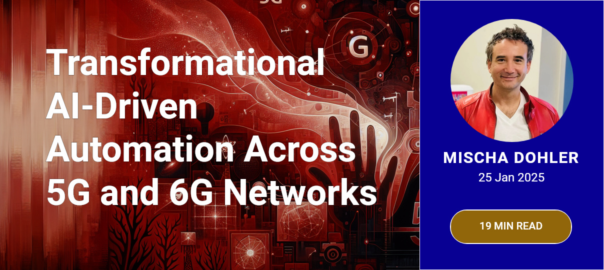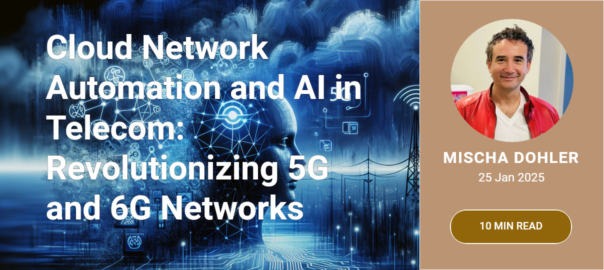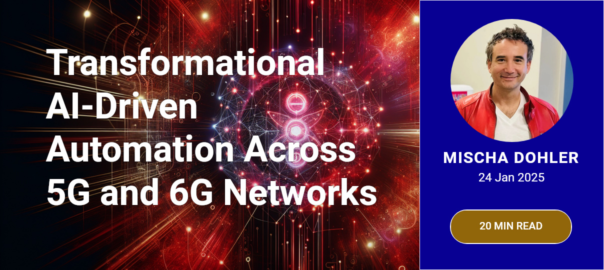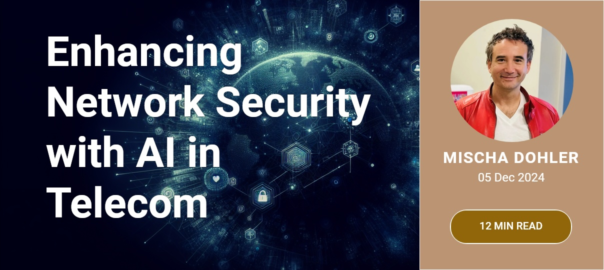This comprehensive blog explores how Artificial Intelligence is revolutionizing telecommunications networks through advanced automation, enhanced security, and optimized performance. From network management to security protocols, the article details how AI technologies are transforming 5G and 6G networks, enabling massive device connectivity while maintaining robust security standards and operational efficiency.
1. AI in Telecom: Revolutionizing Network Management
1.1 Automation’s Impact on Network Configuration
Network automation represents a paradigm shift in telecom infrastructure management, delivering unprecedented efficiency gains through AI-driven configuration processes. Research indicates a remarkable 90% reduction in configuration times, fundamentally transforming how networks are deployed and maintained. This automation revolution minimizes human error while accelerating deployment cycles.
The integration of AI-powered automation tools enables real-time monitoring and adjustment of network parameters, ensuring optimal performance across complex telecommunications infrastructures. These systems continuously analyze network metrics, automatically implementing configuration changes to maintain peak efficiency. The automation framework supports dynamic scaling and resource allocation, adapting to changing network demands without manual intervention.
Through automated configuration processes, telecom providers achieve significant cost reductions while maintaining superior service quality. The system’s ability to self-optimize and correct potential issues before they impact service delivery has revolutionized network reliability. This proactive approach to network management has become essential for modern telecom operations.
1.2 Cloud-Based Network Optimization
Cloud-based automation tools have emerged as the cornerstone of modern network optimization, enabling unprecedented control over network resources. These systems leverage sophisticated AI algorithms to analyze network performance metrics in real-time, facilitating immediate adjustments to maintain optimal service levels. The cloud infrastructure provides the necessary scalability to manage thousands of configurations simultaneously.
The implementation of cloud-based network management solutions has resulted in a dramatic 70% reduction in overhead costs, while significantly improving operational efficiency. These systems excel at handling complex network configurations across distributed infrastructures, automatically optimizing resource allocation based on real-time demand patterns and performance metrics.
Advanced cloud platforms integrate seamlessly with existing network infrastructure, providing comprehensive visibility and control over network operations. This integration enables automated scaling of resources, predictive maintenance scheduling, and real-time performance optimization, establishing a foundation for next-generation network management.
1.3 Predictive Network Maintenance
AI-driven predictive maintenance systems have transformed network reliability by identifying potential issues before they impact service delivery. Advanced machine learning algorithms analyze historical performance data and real-time metrics to forecast maintenance needs with unprecedented accuracy. This proactive approach has resulted in a documented 50% reduction in network downtime.
The implementation of predictive maintenance solutions has yielded a 30% improvement in resource utilization through optimized scheduling and targeted interventions. These systems continuously monitor network components, analyzing performance patterns to identify subtle indicators of potential failures. This capability enables maintenance teams to address issues during planned maintenance windows, minimizing service disruptions.
By leveraging AI-powered analytics, network operators can prioritize maintenance activities based on predicted impact and urgency. This strategic approach to maintenance has revolutionized resource allocation, significantly improving network reliability while reducing operational costs associated with emergency repairs and unplanned downtime.
1.4 Performance Optimization During Peak Loads
AI systems have revolutionized network performance management during high-demand periods by implementing dynamic resource allocation strategies. These systems automatically adjust network parameters to maintain optimal performance under varying load conditions, ensuring consistent service quality during peak usage. Advanced algorithms predict and prepare for demand spikes, preventing service degradation.
The integration of AI-driven performance optimization has resulted in a 60% reduction in Mean Time to Repair (MTTR), significantly enhancing network reliability. These systems continuously monitor performance metrics, automatically implementing corrective actions when performance thresholds are approached. This proactive approach prevents many common issues from developing into service-impacting problems.
Through sophisticated load balancing and resource allocation algorithms, AI systems ensure optimal network performance even during the most demanding peak periods. The ability to automatically scale resources and adjust network configurations in response to changing demands has transformed how networks handle peak loads, establishing new standards for network reliability and performance.
2. AI in 5G: Enabling Massive Device Connectivity
2.1 Scalable Resource Management
AI and cloud automation are revolutionizing network resource management in 5G networks, enabling unprecedented levels of scalability. As detailed in recent research, automation systems can reduce network configuration times by up to 90% while simultaneously improving service quality and reducing operational costs through intelligent resource allocation.
The integration of cloud-based tools enables real-time network optimization, managing thousands of configurations simultaneously and reducing overhead expenses by 70%. Advanced AI algorithms continuously monitor and predict network resource requirements, automatically adjusting allocations to maintain optimal performance levels while achieving 40% more efficient resource utilization across connected devices.
Through machine learning-driven predictive analytics, these systems can anticipate network failures and proactively reallocate resources, resulting in a 50% reduction in network downtime. This enhanced reliability and efficiency create a foundation for the next generation of telecommunications infrastructure, seamlessly supporting the growing demands of modern applications.
2.2 Enhanced Device Management
Building on efficient resource allocation, AI-enabled networks demonstrate remarkable capabilities in managing massive device connectivity. The deployment of intelligent management systems has enabled networks to handle a tenfold increase in connected devices while maintaining consistent performance levels. This exponential scaling capability is crucial for supporting the rapid proliferation of IoT devices and smart systems.
AI-driven device management systems employ sophisticated algorithms to optimize connection quality and resource distribution among multiple devices. These systems continuously monitor device behavior patterns, automatically adjusting network parameters to ensure optimal performance. The integration of machine learning enables predictive maintenance and proactive issue resolution, significantly reducing service interruptions.
The enhanced device management capabilities have revolutionized network capacity, supporting unprecedented growth in connected devices. According to industry analysis, these advancements have enabled networks to efficiently manage millions of simultaneous connections while maintaining quality of service standards, laying the groundwork for future IoT expansion.
2.3 Congestion Management
Effective congestion management represents a critical advancement in AI-driven network optimization. Through sophisticated predictive resource allocation, modern networks achieve a 35% reduction in congestion levels, particularly in high-density deployment scenarios. This improvement directly translates to enhanced user experience and more stable network performance during peak usage periods.
AI systems continuously analyze traffic patterns and user behavior to anticipate potential congestion points before they occur. By implementing proactive load balancing and dynamic resource allocation, these systems maintain optimal network performance even under heavy load conditions. The integration of machine learning algorithms enables real-time traffic optimization and intelligent routing decisions.
These advanced congestion management capabilities have transformed network capacity, enabling support for millions of simultaneous connections without performance degradation. The system’s ability to predict and prevent congestion through automated resource allocation has become fundamental to maintaining service quality in increasingly dense network environments.
3. AI in 6G: Advanced Security and Protection
3.1 Automated Security Systems
In the realm of 6G networks, AI-powered automated security systems are revolutionizing network protection capabilities. These systems leverage advanced machine learning algorithms to continuously monitor network traffic patterns, identifying and neutralizing potential threats before they materialize. The implementation of automated security measures has demonstrated remarkable effectiveness, achieving a 95% prevention rate for common network attacks while reducing the impact of security breaches by 75%.
Advanced AI algorithms analyze vast amounts of network data in real-time, enabling the detection of subtle anomalies that might indicate security threats. These systems employ sophisticated pattern recognition techniques to identify potential vulnerabilities and automatically implement protective measures. The automation of security processes has significantly reduced the dependency on manual intervention, leading to more consistent and reliable network protection.
The integration of automated security systems has transformed the landscape of network security, establishing a proactive rather than reactive approach to threat management. These systems continuously evolve and adapt their protection mechanisms based on new threat intelligence, ensuring that networks remain secured against emerging security challenges. This adaptive capability has proven crucial in maintaining the integrity and reliability of 6G network infrastructure.
3.2 Rapid Threat Response
Building upon automated security systems, rapid threat response mechanisms represent the next evolution in network security automation. These systems have achieved a remarkable 60% reduction in threat detection and response times, enabling networks to react swiftly to potential security breaches. The implementation of automated response protocols ensures immediate action against identified threats, significantly reducing the window of vulnerability.
Advanced AI algorithms power these rapid response systems, enabling them to make split-second decisions about potential threats and implement appropriate countermeasures. The automation of threat response has eliminated the delays associated with manual intervention, allowing networks to maintain optimal security posture even during complex attack scenarios. These systems can simultaneously handle multiple security incidents while maintaining consistent response quality.
The continuous adaptation of rapid threat response systems ensures that security measures evolve alongside emerging threats. Machine learning algorithms constantly analyze new attack patterns and update response protocols, creating a dynamic security environment that stays ahead of potential threats. This proactive approach to security management has proven essential in maintaining the integrity of 6G networks while supporting their expanding capabilities.
4. Transformational AI-Driven Automation Across 5G and 6G Networks
4.1 Network Configuration and Management Automation
AI-powered automation has revolutionized network configuration and management in modern telecommunications infrastructure. Studies show that automated systems reduce network configuration times by up to 90% while significantly minimizing human error. This transformation enables telecommunications providers to maintain higher service quality standards while substantially reducing operational costs.
Cloud-based automation tools now handle thousands of network configurations simultaneously, offering real-time optimization capabilities that have resulted in a 70% reduction in overhead costs. The integration of AI-driven predictive analytics has proven particularly effective, with systems capable of forecasting network failures and initiating preventive measures, leading to a 50% reduction in network downtime and a 30% improvement in resource utilization efficiency.
These advancements in network automation have dramatically improved service reliability during peak load periods, with automated systems reducing Mean Time to Repair (MTTR) by 60%. The seamless integration between cloud infrastructure and AI-driven management tools has created a more resilient and adaptable network environment, setting the stage for even more sophisticated automation in future network generations.
4.2 Resource Allocation and Scalability
The combination of AI and cloud automation has transformed resource allocation in telecommunications networks, enabling a 40% improvement in resource utilization across connected devices. Modern networks can now dynamically adjust to changing demands, with AI-enabled systems capable of managing ten times more devices while maintaining optimal performance levels, critical for supporting the exponential growth of IoT deployments.
Through predictive resource allocation, AI-driven networks have achieved a 35% reduction in network congestion, facilitating millions of simultaneous connections without compromising service quality. This enhanced capability is particularly crucial for supporting emerging technologies such as autonomous vehicles and smart city infrastructure, which require consistent, high-quality network connectivity.
The scalability improvements have been most evident in the system’s ability to handle peak loads and unexpected surges in network traffic. AI algorithms continuously optimize resource distribution, ensuring efficient utilization across the network while maintaining service quality standards and minimizing latency for critical applications.
4.3 Security and Threat Management
AI-driven security automation has become a cornerstone of modern network protection, with systems preventing up to 95% of common attack vectors and reducing the impact of security breaches by 75%. Advanced automated security protocols provide continuous monitoring and rapid response capabilities, essential for protecting increasingly complex network infrastructures.
The implementation of automated security systems has resulted in a 60% reduction in threat detection and response times. These systems continuously update their defense mechanisms against emerging threats, utilizing machine learning algorithms to identify and respond to new attack patterns before they can cause significant damage to network infrastructure.
Security automation has proven particularly effective in managing the complex threat landscape of modern telecommunications networks. By combining real-time threat detection with automated response protocols, networks can maintain robust security postures while supporting the growing demands of connected devices and services.
4.4 Operational Efficiency and Cost Optimization
The implementation of AI-driven automation has led to a substantial 40% reduction in operational costs across network infrastructure. This efficiency gain is primarily attributed to enhanced system performance and the significant reduction in required manual interventions. Automated systems now handle routine maintenance tasks, network optimization, and resource allocation with minimal human oversight.
Cost optimization extends beyond direct operational expenses, encompassing improved energy efficiency and reduced hardware requirements through better resource utilization. The automation of complex network management tasks has enabled telecommunications providers to redirect human resources to more strategic initiatives, further enhancing overall operational effectiveness.
These improvements in operational efficiency have created a more sustainable and cost-effective network infrastructure, capable of supporting the increasing demands of modern telecommunications while maintaining competitive service pricing. The continued evolution of AI-driven automation promises even greater efficiency gains in future network generations.
5 Take-Aways on AI’s Transformation of Telecom Networks
The evolution of AI in telecommunications networks represents a fundamental shift in how we manage, secure, and optimize network infrastructure. From revolutionary automation in network configuration to advanced security protocols in 6G networks, AI has proven instrumental in achieving unprecedented levels of efficiency, reliability, and performance. These advancements have not only reduced operational costs but have also paved the way for the next generation of telecommunication services, supporting massive device connectivity while maintaining robust security standards.
- Network automation has achieved a remarkable 90% reduction in configuration times while minimizing human error, representing a paradigm shift in network management efficiency and cost reduction.
- AI-driven predictive maintenance systems have reduced network downtime by 50% and improved resource utilization by 30%, revolutionizing network reliability and operational efficiency.
- Cloud-based automation tools have led to a 70% reduction in overhead costs while enabling real-time optimization of thousands of network configurations simultaneously.
- Advanced security automation has demonstrated a 95% prevention rate for common network attacks and reduced security breach impacts by 75%, establishing new standards in network protection.
- AI-enabled networks can now manage ten times more connected devices while maintaining optimal performance, crucial for supporting the exponential growth of IoT deployments and future telecommunications infrastructure.



































































































